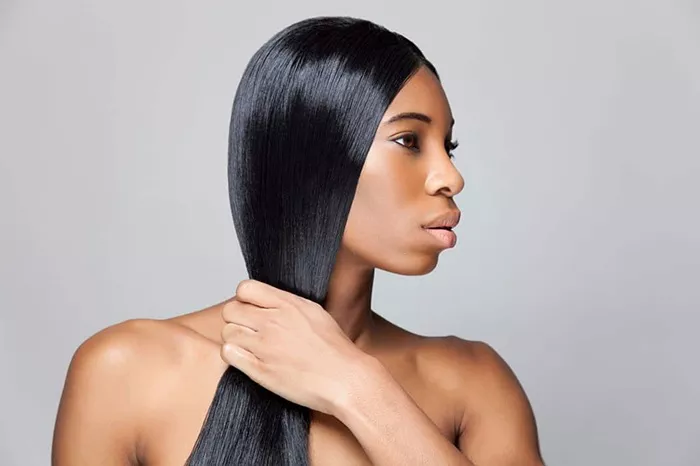Black curly hair, particularly Type 4 textures (4a, 4b, 4c), is characterized by tight coils, high density, and a delicate structure. These curls are prone to dryness and breakage due to their natural oils struggling to travel down the spiral-shaped strands. Straightening this hair type requires a balance of moisture retention, heat protection, and precise technique. Unlike looser curl patterns, Type 4 hair demands careful handling to avoid irreversible damage such as split ends or heat-induced thinning. The goal is to achieve sleekness while preserving the hair’s ability to revert to its natural state.
Before styling, assess your hair’s health. If it feels brittle, shows excessive shedding, or lacks elasticity, prioritize deep conditioning and protein treatments for 4–6 weeks. Invest in high-quality tools: a flat iron with ceramic or titanium plates (for even heat distribution) and a blow dryer with a comb attachment. Avoid using narrow combs or brushes that snag delicate strands.
Preparing Hair for Heat Styling
Preparation is critical for minimizing damage. Start with a clarifying shampoo to remove product buildup, dirt, and oils that block heat penetration. Follow with a moisturizing conditioner containing ingredients like shea butter, argan oil, or hydrolyzed keratin. These components smooth the cuticle and add elasticity, reducing breakage during styling. For severely dry hair, apply a pre-shampoo oil treatment (coconut or jojoba oil) 30 minutes before washing to lock in moisture.
After rinsing, gently detangle hair with a wide-tooth comb while it’s damp. Never detangle dry hair—this causes unnecessary stress. Pat hair dry with a microfiber towel to minimize frizz, then apply a heat protectant spray or serum from roots to ends. Focus on mid-lengths and ends, where heat exposure is longest. Divide hair into 6–8 sections using clips and blow-dry with a comb attachment on medium heat. This pre-stretching reduces the direct heat needed later.
The Flat Iron Technique: Step-by-Step
Begin with small sections (1–2 inches wide) to ensure even heat distribution. Start at the nape, where hair is most resilient. Set your flat iron to the right temperature: 300–330°F for fine or color-treated hair, 340–370°F for medium textures, and 380–400°F for coarse hair. Test a small section first—if it sizzles or smells burnt, lower the heat immediately.
Clamp the iron close to the roots without touching the scalp. Glide it down the hair shaft in one smooth motion, maintaining gentle pressure. Avoid going over the same section more than twice. For stubborn coils, pause for 1–2 seconds midway. Release the hair smoothly at the ends to prevent crimping. Alternate the direction of your iron passes to avoid unnatural uniformity. For baby hairs or edges, use a mini flat iron and wrap strands in a rolling motion for a polished finish.
Once all sections are straightened, run a boar bristle brush through your hair to distribute natural oils and enhance shine. Avoid heavy products like oils or creams, which attract humidity and cause reversion.
Post-Styling Care for Long-Lasting Results
Straightened Type 4 hair is highly sensitive to moisture. To maintain sleekness, sleep on a silk pillowcase and wrap hair in a silk scarf or bonnet. Refresh roots with dry shampoo on day two or three, and smooth flyaways with a drop of anti-frizz serum. Avoid excessive touching or brushing, as oils from your hands can disrupt the style.
Hydrate ends daily with a water-free moisturizer containing ceramides or squalane. These ingredients mimic natural oils without reactivating curls. In humid climates, apply a silicone-based anti-humidity spray to repel moisture. If roots begin to puff, apply edge control gel and press gently with a warm (not hot) flat iron.
Common Mistakes to Avoid
Skipping Heat Protectant: Direct heat melts unprotected cuticles, causing permanent damage.
Overlapping Passes: Repeatedly ironing the same spot thins the hair shaft. Stick to 1–2 passes.
High Heat on Fine Hair: Thin strands can’t withstand 400°F—adjust settings based on thickness.
Styling Dirty Hair: Buildup blocks heat, forcing higher temperatures. Always start with clean hair.
Ignoring Humidity: Use anti-reversion products in moist climates to prevent poofing.
If your hair feels rough or snaps easily after straightening, take a 6–8 week heat break. Focus on protein treatments and deep conditioning to restore strength.
Alternatives to Heat Styling
For those avoiding heat, try:
Tension Blowouts: Stretch hair with a blow dryer and round brush.
Roller Sets: Wrap damp hair around magnetic rollers and air-dry.
Band Stretching: Secure damp hair in sections with hair ties for natural stretch.
Conclusion
Straightening black curly hair safely requires patience. Prioritize moisture, moderate heat, and regular trims. Embrace protective styles like braids or twists between heat sessions. Remember, healthy hair always outshines temporary sleekness. With these steps, you’ll achieve smooth, straight styles without sacrificing your curls’ natural beauty.
Related topics:
HairSpiracy Honors Black Hair Artistry, Culture, and Community in Portland
How to Cut a Bob on Black Hair


